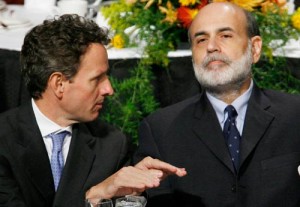For all the phony talk coming out of the White House this past year about transparency and accountability, there actually is an institution outside of the executive branch which does a pretty darn good job at this most of the time: the Inspector General system. In fact, IG’s may do too good of a job by producing lengthy and meticulously detailed reports, difficult even for politically-attuned readers to digest, and which usually do not contain the types of partisan zingers that attract a lot of media attention.

Yesterday the Inspector General for the Troubled Asset Relief Program (SIGTARP) released their Quarterly Report to Congress for the period ending 12/31/2009. The executive summary tells us all we need to know about their assessment of the TARP initiatives over the past year. This whole segment is a MUST READ (it’s not a pretty picture):
The substantial costs of TARP — in money, moral hazard effects on the market, and Government credibility — will have been for naught if we do nothing to correct the fundamental problems in our financial system and end up in a similar or even greater crisis in two, or five, or ten years’ time. It is hard to see how any of the fundamental problems in the system have been addressed to date.
- To the extent that huge, interconnected, “too big to fail” institutions contributed to the crisis, those institutions are now even larger, in part because of the substantial subsidies provided by TARP and other bailout programs.
- To the extent that institutions were previously incentivized to take reckless risks through a “heads, I win; tails, the Government will bail me out” mentality, the market is more convinced than ever that the Government will step in as necessary to save systemically significant institutions. This perception was reinforced when TARP was extended until October 3, 2010, thus permitting Treasury to maintain a war chest of potential rescue funding at the same time that banks that have shown questionable ability to return to profitability (and in some cases are posting multi-billion-dollar losses) are exiting TARP programs.
- To the extent that large institutions’ risky behavior resulted from the desire to justify ever-greater bonuses — and indeed, the race appears to be on for TARP recipients to exit the program in order to avoid its pay restrictions — the current bonus season demonstrates that although there have been some improvements in the form that bonus compensation takes for some executives, there has been little fundamental change in the excessive compensation culture on Wall Street.
- To the extent that the crisis was fueled by a “bubble” in the housing market, the Federal Government’s concerted efforts to support home prices — as discussed more fully in Section 3 of this report — risk re-inflating that bubble in light of the Government’s effective takeover of the housing market through purchases and guarantees, either direct or implicit, of nearly all of the residential mortgage market.
Stated another way, even if TARP saved our financial system from driving off a cliff back in 2008, absent meaningful reform, we are still driving on the same winding mountain road, but this time in a faster car.
But don’t worry, it’s a hybrid.
I am sure the Administration will argue that this report only reinforces the need for the financial regulatory reforms they are attempting to push through Congress. Congress, of course, is likely to water down these proposals due to intense lobbying by the financial industry. But even if they are passed as proposed, they would only slightly mitigate the risk factors identified above. By placing some new limits on the risk-taking behavior of very large financial institutions, and by mandating much broader, and more integrated, regulatory oversight of the financial industry.
Notably, the reforms proposed by the Administration would do nothing to address the systemic risk posed by the federal government’s effective takeover of the residential mortgage industry. Given that the government-brokered inflation of the housing market was the root cause of this crisis to begin with, the fact that the federal government is now underwriting or insuring virtually all new mortgage loans, and has purchased well over $1 trillion of existing mortgage-backed securities, should be of great concern to us all.
The White House is in the midst of a campaign to focus populist anger on Wall Street, which is certainly deserving of some blame for the financial crisis. But by continuing to leverage the future of our children by adding trillions of dollars more to our national debt over the next few years, the Administration is demonstrating where the ultimate blame should reside for the culture of irresponsible borrowing and financial mismanagement which led us to this point. It’s not Wall Street – it’s Pennsylvania Avenue.
COMMENTS
Please let us know if you're having issues with commenting.